Is the 'Commodity Super Cycle' Fizzling Out?
Commodities / CRB Index Aug 28, 2006 - 11:10 PM GMTBy: Gary_Dorsch
By Gary Dorsch, Editor of Global Money Trends newsletter
Since reaching a 25-year high of 365.45 on May 11 th , the Reuters Commodity Index, (CRB index), has been showing signs of fatigue, after a relentless four-year climb. The CRB index doubled from four years ago, led by commodity superstars, such as crude oil, copper, gold, platinum, silver, and sugar. However, since topping out three months ago, the CRB index has slumped about 9%, whipping up speculation that the 'Commodity Super Cycle' is fizzling out.
Defending its decision to pause its two-year rate hike campaign at 5.25% on August 8th , the Federal Reserve predicted that a softer US economy would take the steam out of commodity prices. 'Inflation pressures seem likely to moderate over time, reflecting contained inflation expectations and the cumulative effects of monetary policy actions and other factors restraining aggregate demand,' the Fed said. Putting his fragile reputation on the line, Fed chief Ben Bernanke hinted at a rate pause on July 19th , despite elevated commodity prices. “The recent rise in inflation is of concern, and possible increases in the prices of oil as well as other raw materials remain a risk to the inflation outlook. On the other hand, a slowing economy should reduce inflation pressures,” he told lawmakers on Capitol Hill. 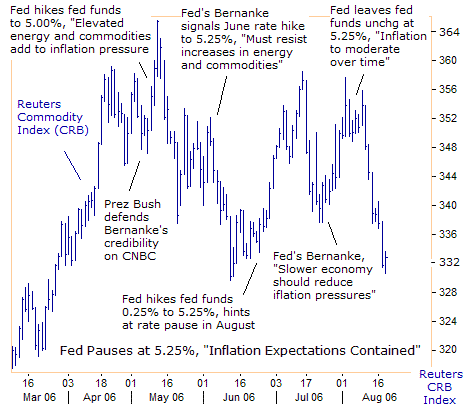
The Reuters CRB index has see-sawed since July 19 th , when Bernanke predicted a slower US economy would contain inflation pressures. Initially, the Reuters CRB index rallied 5% to the 355-level ahead of the Fed's August 8 th meeting. However, schizophrenic commodity traders decided to dump the Reuters CRB index after the Fed meeting, knocking the index 6.5% lower to the 332-level, a two month low. Bernanke's reputation hangs in the balance, subject to the whims of CRB traders. The Fed is betting that a slowdown in the US economy, can keep the “Commodity Super Cycle” under wraps.
If commodity prices are confined into a sideways trading range for an extended period of time, the year-over-year comparison of inflation readings would start to look good. The US economy slowed to a 2.5% annual growth rate in Q2, after sizzling at 5.6% in the previous quarter. Also, Labor Dept apparatchniks have reported US producer prices rose a scant 0.1% in July. Bernanke has authorized three quarter-point rate hikes to 5.25% under his tenure as Fed chief, attempting to transform his reputation from a super-dove into a wise old owl on monetary policy.
The Fed has reached the limits of its tightening campaign, fearful of tilting the US housing market into deflation. Americans are expected to draw $257 billion of wealth out of their homes this year, according to Freddie Mac, and higher rates would put further strain on their budgets and spending.
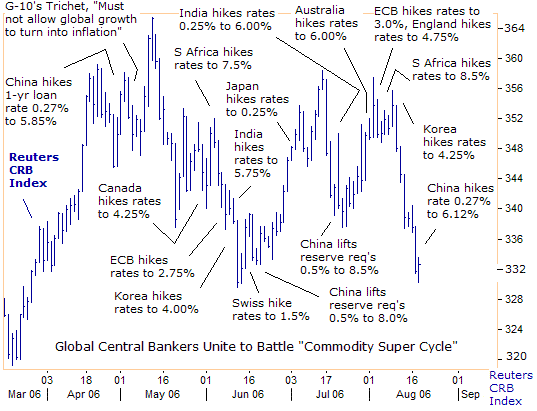
Fortunately, the Fed is getting outside support in the battle against the “Commodity Super Cycle.” With the Fed moving to the sidelines on June 29 th , other central banks from around the globe are picking-up the slack with baby-step rate hikes, or other methods of tightening global liquidity. Foreign central bankers do not want to see the Fed tilt the US economy into recession with a too tight money policy, which could hurt undermine the global economy, and hurt exports to the US market.
Most notably, the Bank of Japan (BOJ), the European Central Bank (ECB), the Bank of England (BOE), the Bank of Australia (RBA) the People's Bank of China (PBoC), the Bank of India (RBI), the Swiss National Bank (SNB), the Reserve Bank of South Africa (RBSA), and the Bank of Korea (BoK), have all stepped up to the plate to raise short-term interest rates over the past three months. The concerted round of central bank rate hikes are starting to wear down the “Commodity Super Cycle,” and more rate increases look likely in Australia, China, the Euro zone, England, Japan, South Africa, and Switzerland by year's end. It's probably fair to say, that the legion of 8,800 hedge funds, which control $1.2 trillion, are losing their speculative appetite for commodities, as global interest rates rise, and were behind the August sell-off in the Reuters CRB index.
Fed's Hands are Tied by Weak US Dollar, Chinese Yuan to Rise
Yet higher interest rates outside the US, combined with a steady Fed policy, might erode the value of the US dollar, and ironically, provide a floor for the Reuters CRB index. So while the Fed's rate hike cycle has probably peaked, the US central bank cannot afford to lower the fed funds rate anytime soon, to defend US homes prices, without triggering a rout of the US dollar. The Fed must wait for the Reuters CRB to fall sharply under its own weight first, before contemplating a rate cut.
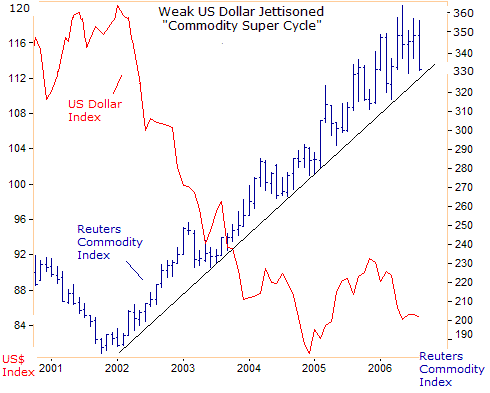
Meanwhile, the US dollar could tumble against Asian bloc currencies, once Beijing loosens its grip on the dollar /yuan peg. US Senators Schumer and Graham are pushing ahead with legislation to impose a 27.5% duty on China's imports, with a vote set for September 30 th , without opposition from new US Treasury chief Henry Paulson. This time, the US Congress is probably serious, and Beijing won't call Schumer's bluff, and therefore allow the US dollar fall to 7.75 yuan or lower, enhancing its purchasing power for global commodities. “China should reconsider its gradualist approach to the appreciation of the yuan,” said He Fan on July 28 th , chief economist at the Chinese Academy of Social Sciences, the government's top think-tank. “Developing a foreign exchange system cannot be accomplished overnight, but the level of the foreign exchange rate can be adjusted overnight.” He Fan said the experience of Japan, South Korea and Taiwan had shown that the economic impact of a rising currency was milder than expected.
Bank of Japan takes the Lead in battle against “Commodity Super Cycle”
Perhaps, the Bank of Japan's dismantling its ultra-easy money policy since March 9 th , has been the biggest stumbling block for the “Commodity Super Cycle” this year. Japan's monetary base, the money in circulation plus bank deposits at the BOJ, has plunged from 114 trillion yen ($982 billion) to 90.5 trillion yen ($780 billion) since January, while the BOJ drained massive amounts of excess funds out of the Tokyo money markets, and then lifted its overnight loan rate to 0.25% on July 14 th .
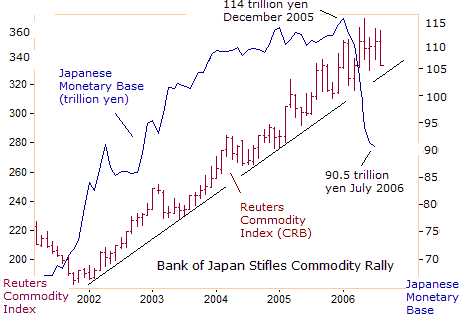
While draining roughly $200 billion out of the Tokyo money market, Japanese traders unwound over extended “yen carry” trade positions, where traders borrowed yen at zero percent to finance purchases of commodities, stocks, and emerging bonds, etc. The Bank of Japan is still on course to lift its overnight loan rate by 0.25% to 0.50% in the months ahead, regardless of the slowdown in Japan's economic growth rate to 0.8% in the second quarter, from 2.6% in the first quarter.
US and Japanese Bond Traders bet on a Peak in Global Inflation
In the US, bond traders are betting that the “Commodity Super Cycle” has topped out for 2006, signaling a peak in inflation, and in turn, the end of the bear market for US 10-year Treasury Notes. Since peaking at 5.25% on June 28 th , the US 10-year Treasury yield has declined by 40 basis points to 4.85%, with monthly US employment gains dropping by a third in Q2 from the previous quarter.
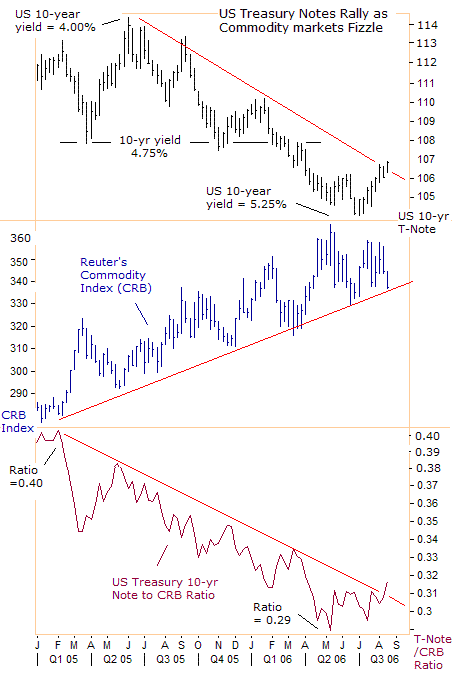
Since the Reuters CRB index topped out at the 365-level on May 11 th , the US T-Note-to-CRB ratio bottomed out at the 0.29-level, and has since turned higher towards the 0.3170-level. With the US T-Note-to-CRB ratio penetrating its downward sloping trend-line, US bond bulls are expressing supreme confidence that the US fed funds rate and 10-year yields have both peaked at 5.25%, and that the good-old days for the “Commodity Super Cycle” are fading into history.
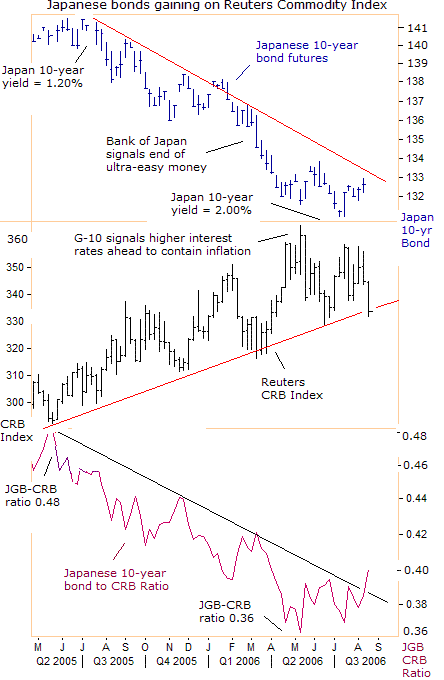
A similar bullish view is seen in Tokyo, with Japanese government bond (JGB) 10-year yields sliding to 1.83%, from as high as 2.00% on July 5 th . The JGB-to-CRB ratio hit bottom on May 11 th at the 0.36-level, and then penetrated a key downward sloping trend-line, mainly due to weakness in the Reuters CRB index, rather than strength in Japanese bonds. Japanese banks are holding a colossal 140.2 trillion yen ($1.2 trillion) of government bonds, roughly the size of Canada's economy, at yields that are far below Japan's 3.4% producer price inflation rate. Japanese bankers are anxious to unload over-extended JGB positions on decent rallies, blunting their upside potential, but an improvement in the JGB-to-CRB ratio might convince the BOJ to limit its rate hike campaign to 0.50% this year. That would leave negative interest rates in Japan, adjusted for inflation, which global traders can exploit for renewed “yen carry” trades in Nikkei-225 or foreign stocks, gold, silver, crude oil, emerging bonds, or any other asset play around the world.
China Embarks on a Tightening Campaign
Commodity traders keep close tabs on China's juggernaut economy, which expanded at an 11.3% annual rate in Q2, its fastest in a decade, for clues about global demand for commodities. The red-hot Chinese economy, single-handedly contributed 13% to global growth last year, and is the world's largest consumer of aluminum, copper, coal, iron ore, steel, buys 20% of the world's silver output, 6% of the global zinc supply, and is the second largest consumer of crude oil. China aims to build up strategic reserves of minerals such as uranium, copper and aluminum to help meet rising demand and provide a buffer against supply disruptions, the Ministry of Land and Resources said on May 10 th . Beijing has already started to build-up a strategic oil reserve of 80 million barrels, and aims to jointly invest with local companies to secure raw materials overseas to make sure the nation's metals needs are met over the next five years.
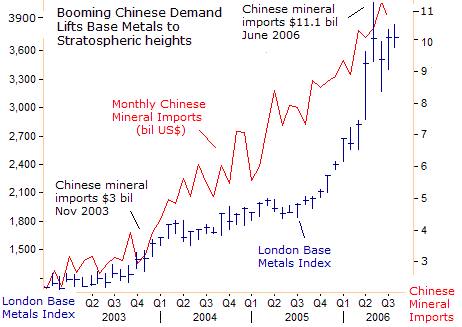
China's economy is riding a boom in exports and fixed-asset investment in factories, roads and housing, and has repeatedly defied expectations of a slowdown. Industrial production was 16.7% higher in June from a year earlier, as it becomes the world's manufacturing base, due to cheap labor and low taxes. Already, imports of minerals reached an all-time high of $11.1 billion in June, quadruple its demand from just three years ago. Base metal supplies are extremely tight, and high prices are boosting the fortunes of metal miners in Australia, Brazil, Canada, and Russia. China is the key engine of growth in Asia. Australia's exports to China soared 42% in the ten months to April 30 th from a year earlier, thanks chiefly to a 22% jump in exports of metal ores and minerals. Japan's exports to China jumped 26.1% to 4.9 trillion yen in the first half of 2006. Korean exports to China, which were growing at a rate in excess of 50% during 2004 and into 2005, have slowed to a pace of 12% in the first half of 2006.
China represents more than 20% of Korea's foreign sales. Any signs of a significant slowdown in China's economy would be of great interest to commodity speculators, government bond traders, investors in base metal miners, crude oil and gold dealers, and foreign central bank officials. On July 26 th , China's Premier Wen Jiabao issued a strongly worded warning about the dangers of economic overheating, and pledged to implement forceful tightening measures and improve the yuan's flexibility.
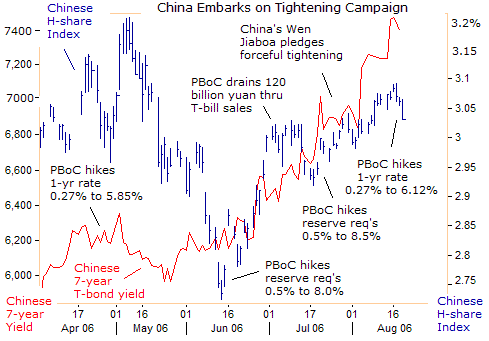
Jiaboa called for a crackdown on red-hot investment that could threaten the stability of the economy. “Fixed-asset investment growth, already rapid, is now accelerating. Growth in money supply and credit is still excessive, and the imbalance of international payments is intensifying. Forceful measures must be taken to help resolve the striking problems that exist, to prevent rapid economic growth from turning into overheating,” Jiaboa declared. Global traders have heard such bellicose declarations from Chinese leaders over the past two years, but the tough verbal jawboning was never backed up with action. However, the People's Bank of China shocked the markets on August 19 th , by hiking the benchmark one-year loan rate by 0.27% to 6.12%, and the five-year loan rate was jacked-up 0.45% to 6.84 percent. The PBoC aims to reduce the supply of middle to long-term loans that usually go on fixed asset investment. Preventing the economy from overheating has become the priority of China's economic planners in recent months. Inflationary pressures are ready to explode in China, with a fourth of manufacturing firms paying more for raw materials, especially crude oil. Employers hired new workers at the fastest pace in 16 months in July, exerting upward pressure on labor costs, which are bound to be passed along to consumers. The era of China exporting deflation could be history.
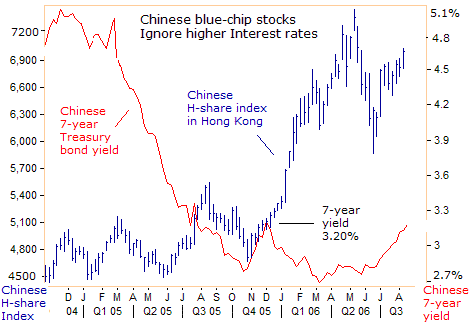
Yet despite the recent half-percent increase in the benchmark Chinese 7-year bond yield to 3.20%, mainland Chinese blue chip stocks traded in Hong Kong are within 4% of their all-time highs. Behind the PBoC's “smoke and mirrors”, it's quite evident that Chinese monetary policy has merely shifted from an ultra-easy policy to an easy policy, with the M2 money supply standing 18.4% higher from a year ago. Chinese 7-year bond yields still remain 2% below their levels of late 2004.
To avoid a hard landing in the juggernaut Chinese economy, the big-4 Asian central banks in China, India, Japan, and Korea are spreading the risk around, by tightening their monetary policies in synchronization. The Bank of Korea took the first step by hiking rates 0.25% to 3.50% in November 2005, and went to 4.50% on August 11 th . The Bank of Japan began to dismantle its five-year ultra-easy money policy in March, the Bank of China hiked its 1-year loan rate to 5.85% on April 24 th , and the Bank of India hiked rates in June and August to 6.00 percent.
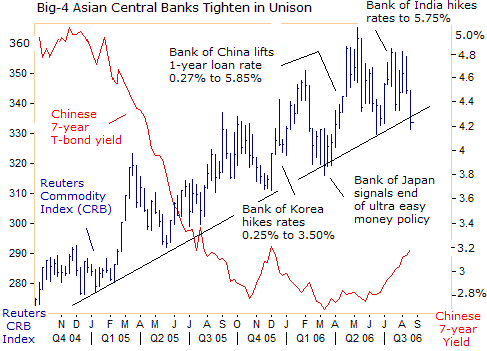
A hard landing in China would send tremors throughout Asia and rock far away places such as Germany, whose exports to China rose 28.1% in the first five months of 2006. But Beijing's leaders are moving cautiously, and simply aim to fine tune the economy towards a 10% growth this year. Still, the latest hike in Chinese interest rates would attract more “hot money” to the yuan, so the next phase of PBoC tightening might center on a yuan revaluation to 7.75 against the US dollar, a bullish factor for commodities in the longer term.
Crude Oil at the Crux of the Global Inflation
Higher crude oil prices give central bankers the biggest head-ache, because of their direct impact on producer prices and secondary knock-on effects on consumer prices. In Germany for instance, producer prices rose 0.5% in July or 6.0% higher from a year earlier, the highest rate in almost 24 years. Excluding energy however, prices rose by 0.5% compared with the previous month and 3.0% on the year. Energy and base metals prices were the biggest reason behind persistently higher German inflation rates. Energy prices increased by 1.0% in July and 15.6% from July 2005, and prices for non-ferrous metals jumped 6.2% on the month and 46.1% from a year earlier. Lead, zinc and tin was up 84.9% on the year and copper and semi-finished copper gained 82.8 percent.
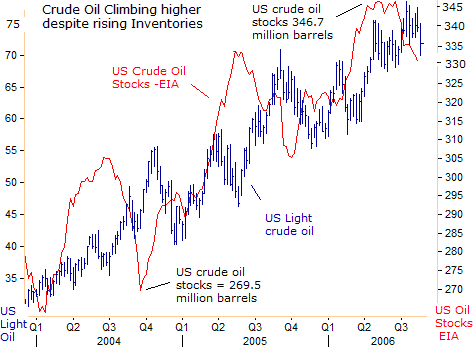
Since January 2004, US light crude oil prices have doubled towards $70 per barrel, even though oil inventories are 22% higher at 331 million barrels, defying the traditional laws of supply and demand. Instead, oil companies are hoarding their inventories, due to fear of future supply shocks, with a razor thin 2.2 million barrels per day (bpd) of global spare capacity, mostly from Saudi Arabia's heavy blend, which is difficult and costly to refine into gasoline.
The Iranian “War Premium” how long can it last?
Crude oil briefly dipped below $70 a barrel on August 18 th , and lost more than 4% for the week, pressured by a temporary truce between Israel and Iran's proxy army in Lebanon. However, crude oil has commanded an Iranian “war premium” of $10 to $15 per barrel for most of this year, as the world frets about the likelihood of a nuclear armed Iranian Shiite regime in the years ahead. On August 20 th , Tehran said it won't suspend uranium enrichment, turning down the main UN demand to prevent it from building atomic bombs.
Iran's defiance is based on a calculation that divisions at the United Nations mean it will only face soft sanctions such as travel restrictions on officials or asset freezes. The world's fourth largest oil exporter, flush with petrodollars, would gladly pay that price, in return for nuclear invincibility, domination of the Persian Gulf, and a world without Zionism. China and Russia are likely to veto any tough economic sanctions that could topple the Iranian Shiite regime, such as an embargo on gasoline sales to Iran, or blocking Iran's 2.4 million bpd of oil exports. Either of these two biting sanctions could cripple Iran's economy, which already suffers from a 12% inflation rate and a 20% jobless rate of workers below 30-years of age. Therefore, with no prospect of tough economic sanctions in sight, Iranian leaders have concluded that the only stumbling block to acquiring nuclear weapons and “wiping Israel off the map” is a pre-emptive US or Israeli aerial attack on its nuclear installations.
Therefore, on August 8 th , Yahya Rahim-Safavi, commander-in-chief of the Iranian Revolutionary Guards warned, “There is no doubt that if these criminals (US and Israel) attempt any operation or vicious assault, they will receive blows 100 times harder. They will not last against the raging sea of the Iranian people and the power of Islamic Iran," he said. Iran will hit Tel-Aviv with its medium-range missiles if attacked, said an influential senior cleric on August 15 th , “If they (US and Israel) militarily attack Iran, they should be afraid of the day when our missiles with 2,000 km range will hit Tel-Aviv," warned Ahmad Khatami, a key adviser to Supreme Leader Ayatollah Ali Khamenei. On August 11 th , Ahamadinejad denounced UN pressure as, “securing the interests that the Zionist regime would fail to secure through a military attack," he said.
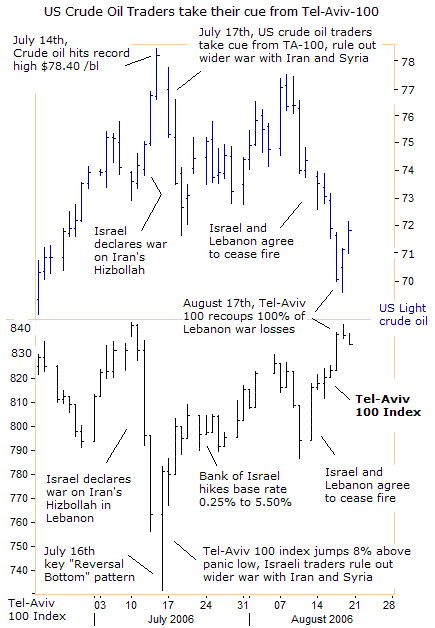
Because Tel-Aviv stood in the cross-fire of the Israeli–Hizbollah skirmish, US traders took their cue for the Tel-Aviv-100 index's “reversal bottom” pattern on July 16 th , which ruled out a wider war with Iran and Syria in the first round, and then dumped West Texas crude oil the next day, from a record high of $78.40 per barrel on July 14 th . The TA-100's recovery to the 840-level on August 17 th , where it stood on the eve of the Lebanon war, briefly knocked crude oil below $70 per barrel. But bullish Tel-Aviv traders might be living in a fool's paradise. On August 20 th , Israel MK Binyamin Ben-Eliezer warned that "the next round of fighting against Hizbollah could be held within several months. You have to read between the lines.
Hizbollah is getting organized, the Syria army is learning lessons. We have to rehabilitate the north, the reserve forces and the army and be prepared for the next round.” According to the London based Arabic daily al-Sharq al-Awast, Iranian Revolutionary Guards have already been dispatched to Syria and Lebanon to rehabilitate Hizbollah, and huge quantities of Iranian weapons have reached Damascus, and are waiting to be transferred to Lebanon. Turkey's Hurriyet newspaper said the Turkish military intercepted Iranian cargo planes carrying missile launchers and Chinese C-802 land-to-sea missiles, identical to the missile that hit an Israel Navy battleship in July. Lebanon's Druze leader Walid Jumblatt said in an August 21 st interview, “I see investigations inside Israel about the Israeli military's terrible performance. I see Ehud Olmert falling and Likud's Benjamin Netanyahu coming to power. There will be a second round of confrontations with Hizbollah and with other regional elements.”
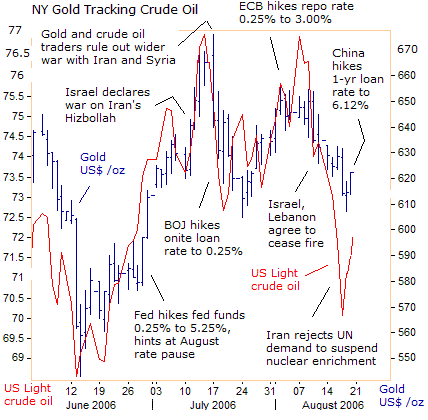
According to former Israel PM Benjamin Netanyahu, “the cease-fire that has been reached is merely an interlude because from Tehran's point of view, the war has to continue, first to achieve their goal of the destruction of Israel, and second to achieve their larger goal, the diminution, subjugation, and ultimately defeat of the West. So we're in a protracted battle, we just had the first round. More will come, and we'll have to prepare our force to overcome them,” he said on August 17 th . Accordingly, the price of crude oil is the major wildcard moving gold prices, the Reuters CRB index, and inflation expectations these days, and could wreck the best laid plans of central bankers to engineer a soft economic landing. It is short sighted to dismiss a second round of fighting in the Middle East, so both crude oil and precious metals could command “war premiums” in the months ahead.
Does a Top in Reuters CRB index Signal a Global economic slowdown?
Over the past few months, the Reuters Commodity index has suffered a series of body blows from 20 different central banks, but does its latest 5% decline signal a global economic downturn, or just the unwinding of over-extended speculative positions? Right now, the outlook is mixed. The Japanese and US economies shifted into lower gears in Q2, but China expanded 11.3%, it's fastest in a decade, and the Euro zone economy grew at a 2.4% annual rate, its best in six years.
Furthermore, the recent round of global rate hikes that have capped the Reuters CRB are deceiving, because global monetary conditions still remain super-easy. In China for instance, the M2 money supply is 18.4% higher, India's M3 is 19.1% higher, Korea's M2 is 9.2% higher, the UK's M4 is 14.1% higher, the Euro zone's M3 is 8.5% higher, and South Africa's M3 is 23.2% higher from a year ago.
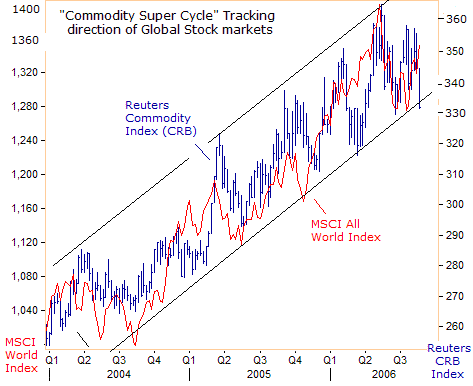
The European Central Bank targets its repo rate at 3%, far below Germany's 6% producer inflation rate, which in turn, encourages speculation in crude oil, base metals, and other key industrial commodities. In Japan, the BOJ's 0.25% overnight loan rate is far below the 3.4% PPI, and in the UK, the Bank of England's 4.75% base rate is roughly half of the annualized 9.6% factory price index.
The explosive growth of the global money supply in developed and emerging economies after 9/11, might explain the buoyancy of global stock markets at a time when sharply higher oil prices, would otherwise have been as a negative influence. For the past few years, the Reuter's CRB index has “followed the money” and tracked Morgan Stanley's All-World Index, for clues about the health of the global economy, consumer confidence, and in turn, the demand for commodities.
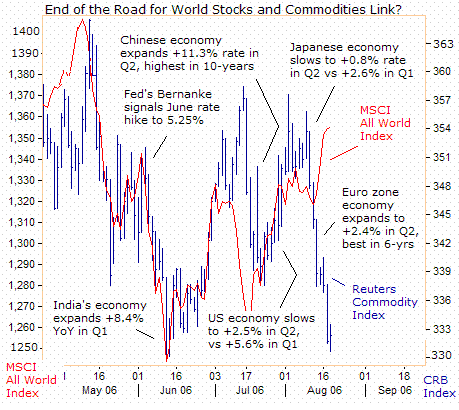
Last week however, the Reuters CRB index and the MSCI All-World stock went their separate ways, threatening the tight relationship between the two markets. Global stock markets rose, celebrating a 10% slide in crude oil prices towards $70 per barrel, while the CRB index was hammered due to its 45% weighting in energy and gold. Such divergences have popped-up from time to time however, but over the long-term, the close relationship hasn't ruptured into a full blow divorce.
A similar divergence developed in March 2006, when the CRB index fell 8%, while the MSCI all World index was left relatively unscathed. Two weeks later, the CRB index rebounded strongly and caught-up with elevated global stock markets. Most likely, the latest sell-off in the Reuters CRB is simply linked to the schizophrenic behavior of hedge fund traders, whose sentiment can turn on a dime, and short-sightedness that rarely projects beyond a week or just a few days.
If global stock markets stay elevated, projecting a stronger global economy, it's only a matter of time until traders recognize that pumped up money supplies and negative interest rates, are also bullish factors for commodities. Throw in a weaker US dollar, led by a stronger Chinese yuan, and a UN showdown with Iran in September, then the “Commodity Super Cycle” could recoup its August 9 th - 18 th losses, led by schizophrenic fund traders bidding crude oil and metals higher.
To read our analysis, forecasts, and inter-market technical charts for the Reuters CRB index, global interest rates, global stock market indexes, US-listed Exchange Traded Funds, foreign exchange rates, gold, copper, crude oil and other commodity markets, Subscribe to the Global Money Trends magazine . Please click on the hyperlink below to place an order now. http://www.sirchartsalot.com/newsletters.php
Disclaimer: SirChartsAlot.com's analysis and insights are based upon data gathered by it from various sources believed to be reliable, complete and accurate. However, no guarantee is made by SirChartsAlot.com as to the reliability, completeness and accuracy of the data so analyzed. SirChartsAlot.com is in the business of gathering information, analyzing it and disseminating the analysis for informational and educational purposes only. SirChartsAlot.com attempts to analyze trends, not make recommendations. All statements and expressions are the opinion of SirChartsAlot.com and are not meant to be investment advice or solicitation or recommendation to establish market positions. Our opinions are subject to change without notice. SirChartsAlot.com strongly advises readers to conduct thorough research relevant to decisions and verify facts from various independent sources.
© 2005-2022 http://www.MarketOracle.co.uk - The Market Oracle is a FREE Daily Financial Markets Analysis & Forecasting online publication.



